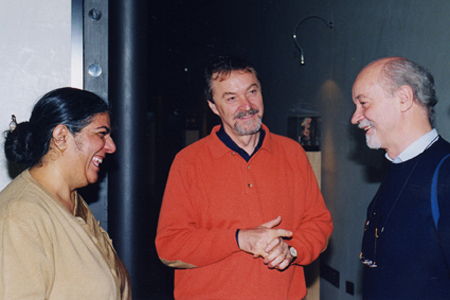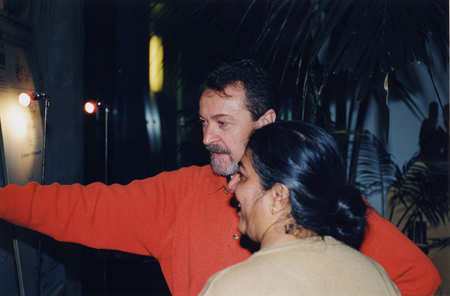Environmental activist and author Vandana Shiva discusses on globalization – Turin, 23-27 October 2008
We highlight here the participation of activist Vandana Shiva at the Terra Madre 2008 International Forum on Future of Food and Agriculture on the 23-27 October 2008 in Turin, Italy. In 2002 Vendana Shiva was awarded with the Premio Mazzotti for Literature – section Ecology; in that occasion she also met Mr. Gabriele Centazzo, chief administrator of Valcucine, and Mr. Lino Centazzo, chief director of WWF organisation in Pordenone.
Vandana Shiva and Gabriele Centazzo, chief administrator of Valcucine
Turin, Italy — I've just come out of the most hopeful and interesting discussions of climate change I've ever witnessed. Anchored by Indian food-sovereignty activist Vandana Shiva, the panel discussion at Terra Madre unveiled a new “Manifesto on Climate Change and the Future of Food Security,” drawn up by the International Commission on the Future of Food and Agriculture.
To me, Shiva and her multinational crew of colleagues (other commission members include Wendell Berry, Jose Bové of Via Campesina, Frances Moore Lappé, and Alice Waters) have articulated a powerful new vision for confronting climate change — one more potent even than Al Gore's famed slides and push for trade-based solutions.
Where Gore dreams of a “low-carbon” or even “carbon-free” world, Shiva pines for a “carbon-rich” future – one in which agriculture systematically builds organic matter into the soil, capturing it from the atmosphere.
Shiva, a forceful and erudite off-the-cuff speaker — opened by running through the manifesto's main points:
-Industrial globalized agriculture contributes to and is vulnerable to climate change
-Ecological and organic farming contributes to mitigation and adaptation to climate change
-Transition to local, sustainable food systems benefits the environment and public health
-Biodiversity reduces vulnerability and increases resilience
-Genetically modified seeds and breeds: a false solution and dangerous diversion
-Industrial agrofuels: a false solution and new threat to food security
-Water conservation is central to sustainable agriculture
-Knowledge transition for climate adaptation
-Economic transition toward a sustainable and equitable food future
After going down the list, Shiva gave a brief history of the global sustainable-food movement's involvement with the climate-change debate. She said that in the '90s, when discussions were going on around the Kyoto Treaty, there were simultaneous talks going on around a Biodiversity Treaty. Unfortunately, sustainable food activists, including herself, were content to let climate talks go on without their input; they focused instead on the biodiversity talks. As a result, she said, discourse around climate has almost completely ignored agriculture — even though industrial agriculture emits something like a third of greenhouse gases.
Shiva didn't say this, but I'll add it: Only by blithely ignoring agriculture's role in climate change can people present abominable ideas like government-mandated ethanol and biodiesel as “solutions” to the climate crisis.
Shiva made what I found to be a novel and powerful point about livestock's contribution to greenhouse gases, recently documented by the U.N.'s Food and Agriculture Organization: If you're going to take animals off of pastures, deprive them of their native foods (i.e., grass for cows, bugs for chickens, whatever the landscape offers for pigs), and feed them a diet heavy on beans (i.e., soy), they're going to get gas — literally, greenhouse gas (methane).
She said more great stuff than I could copy down. She said that in the current economic system, we release 400 years worth of naturally stored carbon every year. Even if we stop tomorrow, we're still going to get extreme droughts, cyclones that wash saltwater into soils, floods that wash away soil nutrients, etc. In that context, locally adapted agriculture is the “only adaption strategy that gives us any hope.”
She said climate treaties and discussions take place in the stratosphere — in congressional committees, exclusive global confabs peopled by CEOs of vast business empires, etc. She said these people operate under an industrial paradigm, and the solutions they concoct to climate change — cap-and-trade mechanisms, GMO seeds, etc. — mimic and don't challenge that paradigm. While she was talking, I thought of the extraordinary set of charts from New Scientist that David Roberts posted last week — the ones showing the titanic rise of resource consumption and industrial activity in the last century.
I realized why certain right-wingers so vigorously deny human-provoked climate change, and why technocrats push “market-based solutions” to it: because climate change amounts to a tremendous rebuke, from the very earth we stand on and the air we breathe, to industrial-scale economies. The initial answers are denial or desperate attempts to rejigger industrial economies, to make them “carbon-free.”
But in the end, these attempts get nowhere. Real reform, Shiva insisted, will happen when discussions move from the stratosphere to the soil, and when we find new, non-industrial ways of thinking.
Shiva responded well to questions from the audience. A Londoner who runs two “sustainable” restaurants said that his clients ask him all the time if the world isn't doomed, because China and India are rapidly developing into Western-style economies, and using huge amounts of resources along the way. Given that reality, why should Westerners even try to be “sustainable”? He said he needed help with how to answer these questions — all he does now is stammer something about how “maybe we can show them [Indians and Chinese] a more sustainable way …”
Before turning the floor over to Shiva, the moderator pointed out that the average American uses the resources of something like 10 to 15 average Indians. Then Shiva made some excellent points about how the explosion of the Indian and Chinese economies pays tribute to the consumptive power of Americans and Europeans — we've gutted our own industrial bases and moved them east, in search of cheap labor and lax environmental controls.
She said that something like 5 percent of Indians have benefited from this trend, and added that per capita food consumption for most Indians had actually declined in the past 20 years. Food security, meanwhile, has been threatened. She pointed out that peasant farmers in India's most fertile area are fighting to save their land from being swallowed up by a car factory. She might have added that China's most productive farmland is under severe pressure from industrial pollution and expansion.
Another Englishman, from The Independent, pointed out that the last time “our preferred ways of agriculture” held sway, global population could be counted in the hundreds of millions. Today we are 6.7 billion — and growing. What do you say to folks who insist that a return to community-scale, low-input ag will cause millions to starve?
The question was asked with the air of “all very nice indeed, but serious people concern themselves with feeding the world, and you people are being nostalgic.” Shiva responded like Babe Ruth taking aim at a slowly gliding softball.
First, she pointed out that for all of industrial ag's vaunted food-production power, 1 billion people — and growing — live with hunger. Then she forcefully made the point that mixed-crop agriculture that relies on compost is actually many times more productive on a per-acre basis than industrial monoculture. She also noted that locally adapted agriculture is not a fixed, static thing — it evolves and responds to changes in the land and climate. So which style of agriculture is it that threatens millions with starvation? Case closed.
Via: Energy Bulletin
LATEST POSTS










